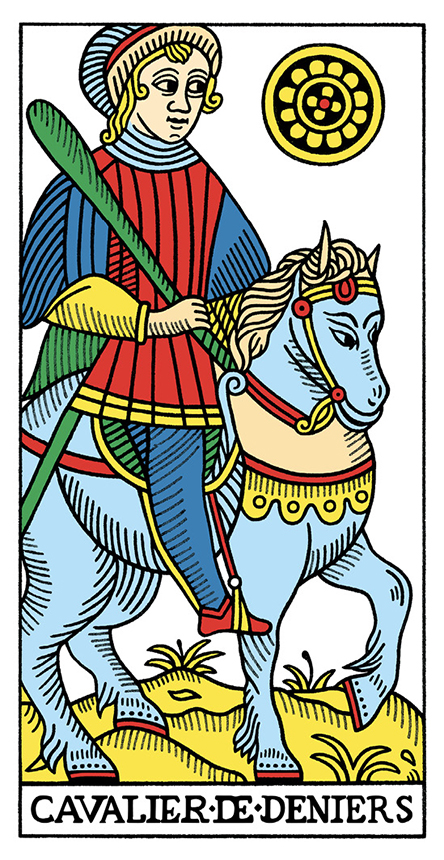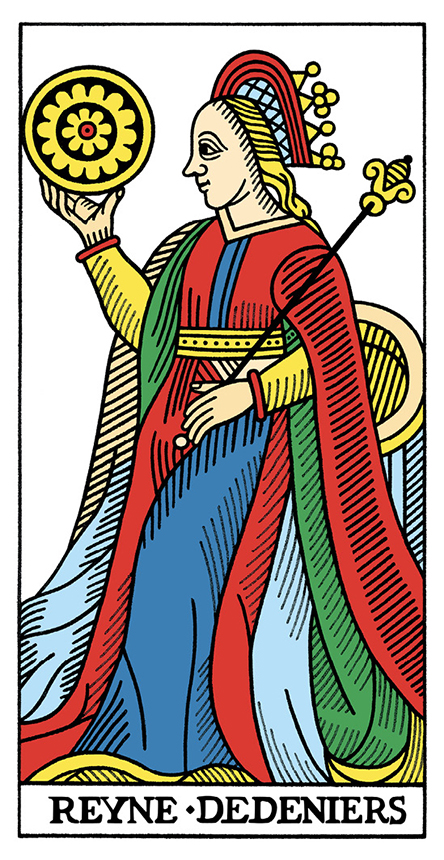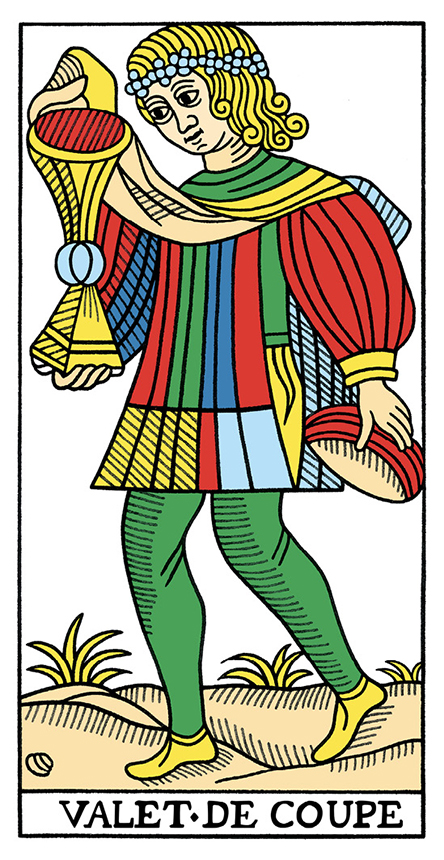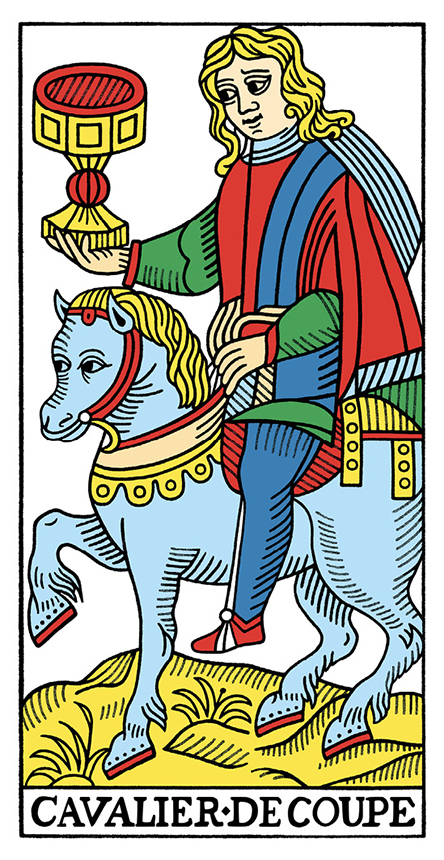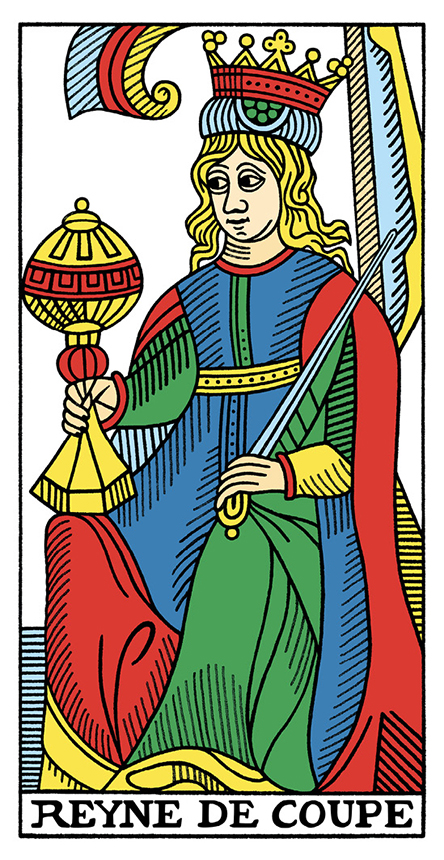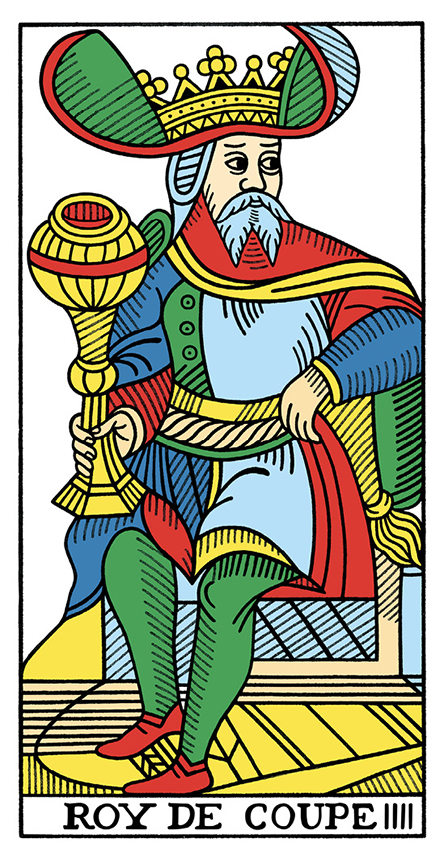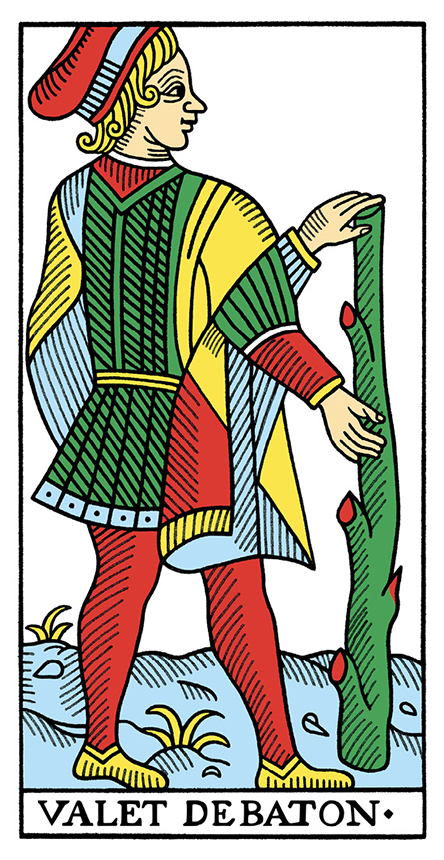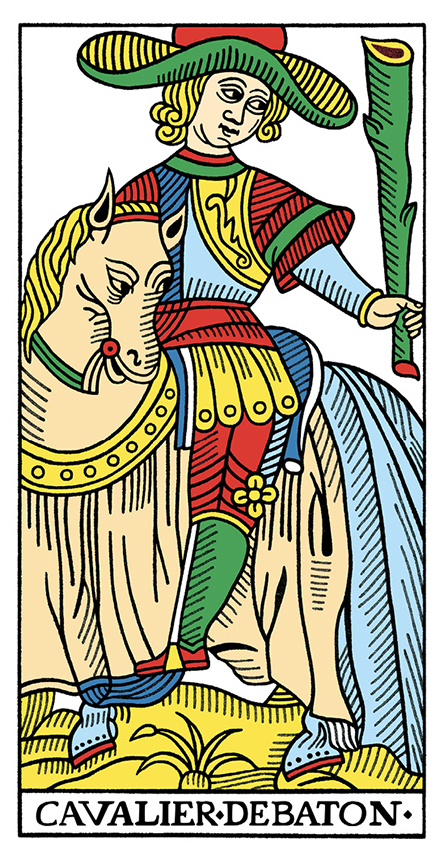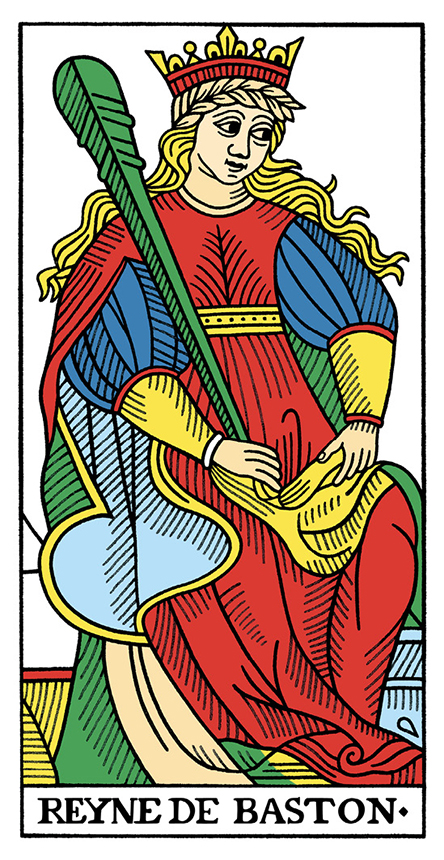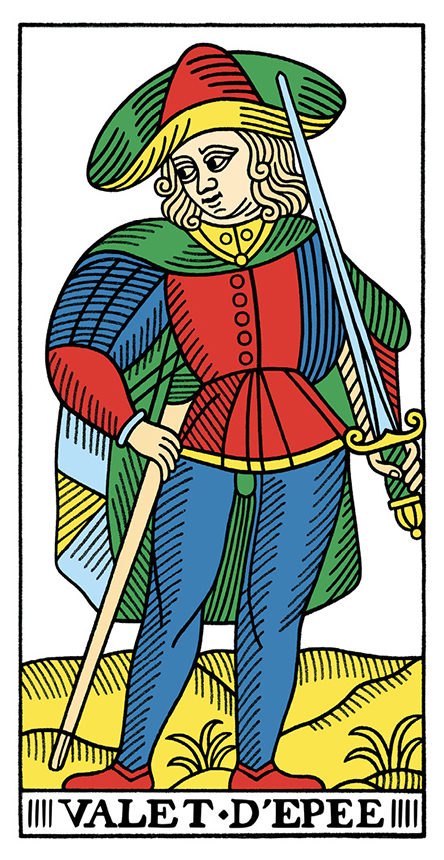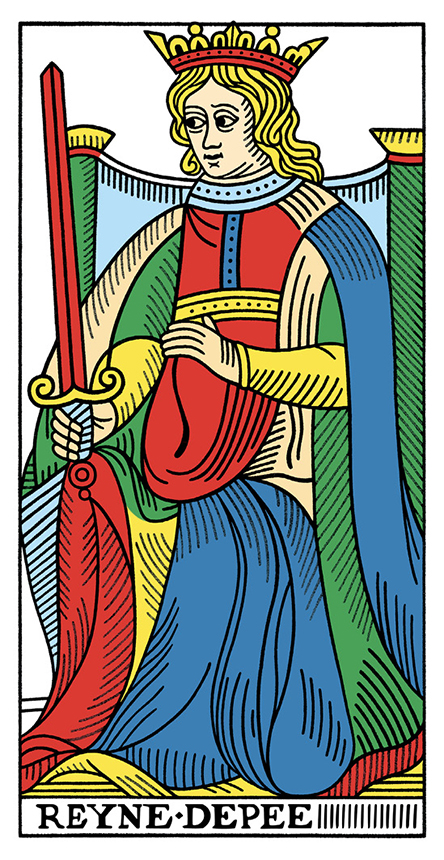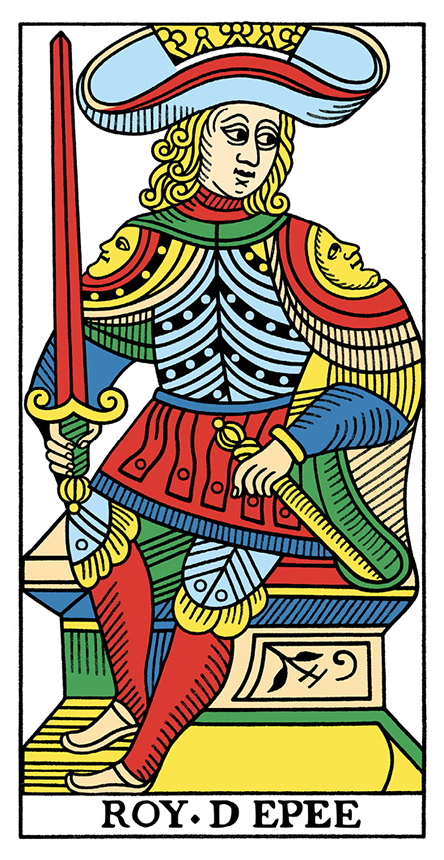chapter • 9
The Court Cards
Ranks and Suits
Each of the four minor suits includes four court cards, which represent four ranks, or positions, in the aristocratic hierarchy of the Middle Ages. In ascending order of status, these are:
- • A page, marked valet. The French term indicates a subordinate, and in the context of the other cards he can be either the knight’s servant or his apprentice (a squire). In either case he is a young man of low position, but as an apprentice he may rise in the future to be a knight himself. All the pages in the cards are young men standing with their feet on the ground.
- • A knight, marked cavalier (an old spelling, today it would be chevalier). All the knights are mounted on horses (chevals in French).
- • A queen, marked reyne (today spelled reine). The queens are crowned and seated on thrones, with their feet hidden under robes.
- • A king, marked roy (today: roi). The kings are also crowned and seated on thrones, but their posture seems unstable and their feet are showing.
Three of the four tarot court ranks also appear in ordinary playing cards: a knave or jack (who replaces the page), a queen, and a king.
The court cards may, on first sight, resemble the major suit cards, as they also display human figures and carry card titles, but there are important differences between the two card types. First of all, while in the major suit there is no clear pattern in the organization of the cards, the court cards can be arranged in a well-ordered four-by-four table: four ranks in each of the four suits. This gives the court cards a much more orderly and schematic structure.
Another difference is that in the major suit there are many mythological and symbolic figures, and as the suit develops these figures gradually lose their social function, as well as their clothes. By contrast, there appears to be no explicit mythological or mystical references in the court cards. All their figures are dressed, and their ranks identify each one of them with a definite social status. This means that the resemblance between the court and the major cards is felt most strongly at the major suit’s beginning, which represents the everyday life of earthly existence, and much less in the abstract cards at the major suit’s end.
The symmetry of the four-by-four table makes it possible to see a correspondence between the ranks and the suits. The four pages are standing on solid ground, which links them to the suit of coins. The knights mounted on horses express dynamism and movement typical of the wands suit. Also, the horse touching their pelvic area can represent the animal forces of desire. The original form of wands as polo sticks in the Mamluk playing cards can also be linked to the horse-riding polo players. The female figures in the queen cards express the domain of emotion represented by the suit of cups. And finally, the kings’ domination, resolution, and mature wisdom correspond to the combative, decisive, and intellectual suit of swords. As with the body parts, in this correspondence the suits are arranged from lowest to highest by their symbolic ordering of evolution: coins, wands, cups, swords.
In studying the court cards, it’s a good idea to lay them all down in the square table form — that is, in a four-by-four array — with the ranks as rows going from bottom to top (page, knight, queen, and king) and the suits as columns going from left to right. Now we can look at the card images and note their common features and differences. We can lay the suits in columns from left to right according to the symbolic ordering just mentioned, but in order to notice the design features that distinguish the soft suits from the hard suits, it is better to arrange them by suit types: coins and cups, followed by wands and swords (see table on following page).
Ordering the columns in this way, we can notice that many figures in the hard suits look warlike and inclined to action, while figures in the soft suits generally look more peaceful and relaxed. The kings of the hard suits look young. They wear armor and hold their weapons with confidence. The pose of their bodies hints at imminent movement toward the right. The kings of the soft suits, on the other hand, look older and more settled. They are also looking toward the right, but their posture suggests caution and restraint.
As for the queens, they look closed and defensive in their posture, and in some way they are all armed. In the hard suits they hold their big weapons in a threatening manner. In the soft suits, though, they only have a sort of rod resting on their left shoulder. This looks rather like a defense against possible attack from behind, and they seem to be more concerned with the nonaggressive suit symbols that they hold in their right hand.
The knights of the hard suits wear some kind of armor-like decoration. It is less elaborate than the kings’ armors, but still it gives them a more combative appearance than the civil clothing of the knights in the soft suits. It is only in the page cards, especially the Page of Wands, that we cannot see the more warlike character of the hard suits. But still, we can also assume that the page is preparing himself to use his wand as a mace at some later stage.
In a reading a court card can represent the querent or another person involved in the question. Alternatively, a court card may represent a course of action or an attitude toward the issue of the query. In such a case, several court cards can refer to the same person and indicate different aspects of their attitude or behavior. We can also ask the querent directly who or what the figure in the card reminds them of. As with the major suit cards, here, too, a male figure in the card may refer to a woman or vice versa.

A Four-by-Four Table of Court Cards
The Human Figures
Having a similar structure with fewer details, the court cards are sometimes treated as some sort of poor relations of the major cards, but this view overlooks their unique qualities. No doubt they are less sophisticated, less surprising, and less dramatic than the major cards, but this is exactly why we can see their figures as more human, friendly, and down to earth. They are not involved in extreme and bizarre situations, nor do they look up to the sky or down into the abyss. Neither do they try to represent abstract moral principles. Instead, in the court cards we see human beings leading a normal life, each of them having a definite status in society and belonging to a particular family, or suit.
For people who don’t know the tarot, the major cards can appear intimidating, with their mysterious and complex “larger than life” symbolism. In comparison, the simpler and more earthly character of the court cards can make it easier for people to relate to them emotionally. Even without having studied the court cards systematically, we can look at the figures and start by asking ourselves questions: Who is this person? Why is he sitting or standing in such a way? What exactly is he doing with his suit symbol, and how is he treating it?
This possibility of looking at the court cards just as we look at ordinary people opens up new ways of using them in a reading. For example, instead of shuffling the court cards into the deck as part of a regular spread, we can use them separately to help a querent express their own feelings in their own words.
I sometimes use such a technique with querents who find it difficult to open up and share their concerns with me. First I separate the court cards from the deck and spread them with their faces up. I ask the querents to concentrate on their feelings about the issue and pick up the card whose figure echoes them most closely by posture or facial expression. Then I ask them to look again at the card, describe the features that catch their attention, and comment on their reasons for having chosen it. These include both their explicit thoughts while picking it up and the insights that they get from a closer examination of the image details. Having listened to their description and shared my own thoughts about it, I then proceed to a three-card spread from the major suit.
Table and Image
In Chapter 5 we discussed the elements of order and chaos in the major suit. As we saw, the suit presents a complex interplay between the two. The regular four-by-four table of the court cards expresses a much higher degree of order than the haphazard sequence of the major suit. It also expresses the stability of the number four. This stability goes well with the established order of the feudal figures shown in the illustrations, but there is also a strong element of chaos. To see it, we should look closely at the images.
Each court card figure is drawn in a unique posture and with unique details. Some figures are looking to the left and others to the right, some are shown in an artificial environment and others in a natural landscape, some have their head covered with a hat or a crown while others are bare-headed, and so on. Any rule that we can try to find in such details seems to have its exceptions.
Features involving the suit and rank of the figure also show exceptions. On each card the suit symbol appears once, but the Page of Coins card shows two coins. There are also cards with an additional suit symbol from another suit, such as a wand in the Knight of Coins or a sword-like rod in the Queen of Cups.
A more surprising indication of chaos in the court cards is the titles. It is surprising because, in principle, titles such as “King of Cups” should express the ordered table structure. But there are numerous irregularities and exceptions in the written titles of the Conver deck. Most of the court cards’ titles are written inside a strip at the bottom of the card, but in the Page of Coins the title is written down the side. The titles of three suits are in the singular form, but the coins are written in the plural, deniers, and not denier. In the wands suit the suit name is baton on three cards, but on the queen card it is written in an older spelling: baston. And — as in some major cards — there are also many dots and groups of vertical lines in the titles, with no apparent pattern.
These two aspects — the orderly table structure and the more chaotic image details — form the basis of two methods for interpreting the court cards. We shall refer to these methods as interpretation by the table and interpretation by the image. Many writers writing about the Tarot de Marseille in the last century have combined elements from both of them.
The interpretation by the table is based only on the suit and rank of each card. In this method each rank represents an attitude or a stage in a process, as we shall elaborate in the next section. The suit indicates the domain or the stage in which this attitude finds its expression. For example, a knight can symbolize progress toward some goal. In the suit of coins it may be about a business initiative that has already started to move toward realization. Note that the interpretation by the table does not refer to the details of the illustration; only the suit and rank that define the card’s place in the table are significant. Therefore, we can reach similar interpretations from the table with decks in which the court cards are differently drawn.
The interpretation by the image is essentially similar to the intuitive perception of the human figures that we described above. We can make it more systematic by applying the symbolic language of Chapter 4. In addition, we can refer to the unique features of the card title and think of possible meanings for them.
The two methods of interpretation actually have been applied already in our discussion of the ace cards. The table structure of the aces is much simpler, as it consists of only one row and four columns. Still, we rely on it when we say, for example, that the Ace of Coins can represent a new business initiative. This interpretation comes from crossing the number 1 (beginning) with the suit of coins (practical domain). On the other hand, we apply interpretation by the image when we speak, for example, about the masculine and the feminine aspects of the Ace of Wands. We get this information not from the number and suit of the card, but rather from the shape of its main object.
The Four Ranks
The four ranks of the court cards can be interpreted as four phases of a process. The page represents an initial phase characterized by hesitation and uncertainty, a humble position and limited resources. The knight is already in movement toward an achievement or a goal, but his ability isn’t yet fully developed and his attitude isn’t completely mature. The queen represents a phase of realization. She can enjoy the fruits of her past achievements, but her tendency to preserve them may block her from advancing further. The king represents a process that has reached its peak and is now going past it. In this phase whatever has been accumulated and learned can serve as a starting point for the next move.
the pages
The pages appear as youths with a soft and slightly feminine appearance. They are standing or walking on untilled ground, and their posture expresses hesitation and lack of confidence. The coins and swords pages are standing with their feet pointing in opposite directions; the Page of Cups even seems to be stumbling on the uneven ground. The Page of Wands’s suit symbol is a huge trunk blocking his way. In addition, the suit symbols themselves appear almost too heavy or complex for them. The Page of Coins is holding only one coin out of two. The Page of Wands has a wand that is too large to hold comfortably. The Page of Cups is trying to look into a cup that seems too deep. The Page of Swords rests his heavy sword awkwardly on his shoulder, almost as if he is going to cut off his own head.
A page card may represent a person acting in a new and unknown field. At this stage he still lacks proficiency and has little control over his environment; therefore, he is unsure in his actions and decisions. His status as page may also indicate that he is still dependent on others better positioned than him. On the positive side, he may represent a fresh approach, someone ready to learn and improve, and can expect help from others as well as forbearance for his beginner’s mistakes. A page card may also represent a person who is young in age or attitude, or signal a lack of maturity and responsibility.
the knights
The knights are all mounted on horses in an open and untilled landscape. The suit symbol is either held in their hand or is in front of them. The knights of the hard suits, wands and swords, have a decorated outfit or some sort of armor, and their horses are covered with large pieces of cloth. The knights of the soft suits, coins and cups, wear simple clothes, and their horses are more exposed. The knights seem a little older than the pages, but still they all have yellow curls, except for the Knight of Swords, whose hair is hidden. Each of the horses’ shoes is held in place by five nails, except for one hoof with four nails in the Knight of Cups.
A knight mounted on a horse can symbolize a person advancing toward a goal. Medieval representations of the knight portray him as an embodiment of the values of honor, courage, and virtue. He is supposed to be dedicated to the service of others: his feudal lord, the church, some lofty cause or perhaps, in a romantic vision, his queen. The idea of being on a mission can suggest responsibility and commitment. The horse may also represent people that he is “riding on,” meaning those under his control and in his service. It could also signify the means by which the knight is able to move and to act.
the queens
The queens are drawn as mature women sitting on a throne and wearing a crown. They are dressed and covered, their faces are serious, and their posture looks solid and stable. Each queen holds her suit symbol in her right hand, while the left is positioned level with the belly. The queens of the soft suits, coins and cups, hold a rod or a sharp scepter in their left hand, as if to protect them from an unexpected attack from behind. The queens of the hard suits, wands and swords, hold their suit object like a mighty weapon.
The queen cards may express achievements and realization, solidness and stability, a strong position and real assets. But trying to preserve their existing position, they may also be conservative and defensive, cautious, suspicious of the unknown, and unwilling to take risks.
the kings
Each of the kings wears a hat with a wide brim opening upward, and three of them also have a crown. The fourth, the King of Coins, also has an implicit crown in the yellow triangles on his hat. We can interpret the open hat’s brim as readiness to accept new influences and ideas, and thus to change and develop. The kings of the soft suits, coins and cups, look like mature men; they have beards split in two, and they are dressed in gowns. Their appearance symbolizes maturity and cautious wisdom, and their split beards may express the ability to see separate and conflicting aspects of a situation. The kings of the hard suits, wands and swords, are younger; their faces are smooth, and they wear armor. Their appearance and their posture suggest action and dynamism.
Each king holds his suit symbol in his right hand. Three of them also rest it on their knee. Their thrones are not symmetrical, and their posture looks unstable. Their feet turn to the left but their faces turn to the right, and it seems that they might get up at any moment. We can interpret the lower part of their body as old habits and patterns of the past, while the upper part represents readiness to move forward to the future.
The kings may express a position of power and control or a phase of maturity and experience. The old processes in which the king was involved have reached their end, and now he is ready to move in a new direction.
Page of Coins
The page is looking at the coin in his hand. He may be unaware of the other coin near his foot. This indicates that he realizes only part of his potential, while the rest may still be hidden in the ground. The focused gaze at the upper coin may indicate that the querent is concerned with what they already have. The feet pointing in opposite directions express indecision. Perhaps the page had an initial success and now, examining it, he hesitates between exploiting the current situation (the second coin) and taking a new direction (the higher foot on the right). A unique feature of this card is that the title is written down the side and not in a strip at the bottom. This gives the card a solid basis, as the page’s feet are planted on the ground at a level lower (or deeper) than any other figure.
interpretation: A practical attitude, feet on the ground, but a vision that is limited to existing structures and what has already proven its worth. Even in the present situation, many advantages and possibilities may be missed because of insufficient attention. It is worth looking for these untapped potentials and benefits before embarking on an altogether new way. Hesitation, restlessness of spirit, and an unclear feeling that something is missing. Goals that we seek might be closer than we imagine, and all we have to do is to look in the right direction. A solid material base for future endeavors.
Knight of Coins
The knight looking at the coin in front of him may have aspirations or plans in the material domain. The horse marching to the right indicates movement toward a realization of these plans. But the four slices of the center of the coin lean slightly to the right, as if the coin is rolling and moving farther the closer the knight gets to it. The green wand that the knight is holding in his hand may hint at the suit of wands. It may indicate creativity and self-expression, which the knight wishes to combine with material considerations. For example, this could indicate a desire to find a job that would guarantee both personal satisfaction and a good salary. Yet the wand may also make the coin fly out of reach, meaning that personal desires can spoil practical plans. We can also think that the knight is chasing the coin, meaning that he is motivated by the thought of profit and personal gain.
interpretation: Advancing toward a tangible goal that seems close at hand but somehow evades our actual grasp. An aspiration to combine creativity and self-expression, on the one hand, and material considerations on the other hand. Personal impulses might interfere with practical plans. Looking for short-term gain may lead the querent forward to find other things that they do not yet expect. Constantly chasing after money, either due to a real need or because in this frame of mind one can never have enough.
Queen of Coins
The queen’s coin is the largest and the most developed of all the coins in the court cards. It is the only one that has a point at the center, similar to the focusing point in the major suit’s Hermit card, and it completely fills her field of vision. The stare directed to the left side of the card and the back turned to the right signify attention to past achievements and to existing assets that the queen holds in her hand, rather than to new possibilities and future plans. The scepter in her other hand can also be interpreted as a kind of wand. It forms a fixed triangle with the point at the coin center, which strengthens the impression of a deep focus. The small white circle level with her abdomen signifies a sense of feeling at ease with her inner self, as if her center is where it ought to be. The lines of the dress flow gently toward the ground, giving an impression of stability and signaling a solid basis in the material domain.
interpretation: A practical and well-focused view that has already proved itself in real achievements. Good intuitions in practical matters of money and material goods. Stable situation that still demands constant attention to maintain. Being content with what one has, feeling at ease with oneself and with one’s assets and position. A conservative attitude that seeks to preserve the existing state. Resistance to change that is felt to be a threat and not an opportunity. An overly materialistic attitude that sees everything only from the perspective of tangible gain and loss.
King of Coins
The King of Coins differs from the other kings in that he doesn’t have a visible crown. He also sits in an open, natural landscape, while the others are shown in artificial environments. This may indicate a simple and practical, down-to-earth attitude of one who avoids excessive luxury or pompousness. He also differs from the other figures in the suit who are looking intensely at their coins. Instead, he holds his coin in his lap, treating it as something secure that doesn’t need special attention, while his gaze is directed to the future. His line of vision is open but well defined by the limiting lines of the hat and the shoulder. His body leans slightly back — a posture expressing reticence, caution, and critical examination of new things rather than rushing forward toward them. The crossed legs and the hand on the belt resemble the major suit Emperor card and indicate discipline and self-control.
interpretation: A solid and reliable attitude toward practical affairs. Keeping things simple and useful, without excessive sophistication. A cautious and balanced approach toward suggested projects or tempting offers, not rushing forward with uncritical enthusiasm, but also not altogether blocking the possibility of development in new directions. Self-control, maturity, and responsibility, especially in business and practical matters. Modest and unpretentious behavior based on confidence in oneself and in one’s achievements.
Page of Cups
The page is looking into his narrow cup, but his focus remains only in the top part and does not penetrate the deep layers. The round object in his other hand may be either his hat or the lid of the cup. The act of gazing into the cup can express readiness to examine his own emotions, and the uncovered head indicates an open mind. The cloth covering the cup from behind indicates that the page is undergoing this process only with himself. The movement to the left expresses an occupation with the past, and the page’s left foot appears to stumble on the uneven ground, as if he may get stuck or even fall down. The shape and coloring of the ground may also suggest a female human body and indicate perplexity and inexperience in romantic affairs. On the belt there is some sort of hidden dagger, which may indicate the ability to hurt, maybe even without conscious intention.
interpretation: A fresh and inexperienced attitude in emotional matters. Sentimentality; being moved by one’s own feelings but without understanding them deeply. An attempt at self-examination that remains superficial, as it is not shared with others. Hesitant steps in the romantic or erotic domain. Preoccupations with one’s own feelings may disrupt practical progress. Sincere intention, but still a possibility of hidden and unintentional aggression.
Knight of Cups
The knight holds out the cup in the palm of his hand as if presenting it in a romantic act of devotion. The modest clothes, the exposed natural curls, and the spare ornamentation on the horse emphasize a feeling of openness and simplicity. The cup is large and open, but also flat and lacking depth. The knight looks hesitant, and one may think that the cup isn’t really positioned on his hand. It could be floating in mid-air, and the knight may just be putting his palm underneath it. The knight supposedly gives what he has, and he may be sincere, but it isn’t certain that one can rely on the depth of his commitment. The direction to the left might signal giving up personal goals and ambitions.
interpretation: Devotion, emotional giving, openness, and sincerity. Giving up personal goals in order to serve something or somebody one cares for. The image of a romantic knight, which might be authentic but also may be a kind of self-delusion. Devotion without hidden motives. Open expression of emotions, but they may be only at a shallow level. A romantic and idealized view of reality motivates the querent, but perhaps not in a productive direction.
Queen of Cups
The queen’s cup is the only closed one in all of the suit’s cards (a trait that was also preserved in the new Waite deck). The closed character of the image is also expressed in her heavy headgear, the chest bound with a tight belt, and the canopy that leaves only a narrow opening in front of the queen’s eyes. The queen holds the cup on her knee, with her palm in a centered position that expresses a desire to control. The scepter in her other hand looks like some sort of sword or weapon, as if the queen is wary of a possible attack from behind. The closed cup and the tight chest also indicate blocked emotionality, while the elaborate headgear and the sword-like scepter may represent cerebral self-control.
interpretation: A rich but hidden inner world. Stunted and controlled emotion under an external guise of the intellect. Closing in and defending oneself; difficulties in opening up emotionally. A person who has a lot to offer, but one has to make an effort to reach them. Guarding something of value. Seeing things through the narrow perspective of past experience, possibly traumatic, without opening up to new possibilities. Being emotionally content spending time with oneself. A secure feeling in the present situation.
King of Cups
The cup in the king’s hand resembles the closed cup of the queen, but it has a narrow opening, which may symbolize the controlled expression of emotions. The cup appears to be divided into two parts held together by the hand but having a small misalignment. We can see this as an emotional rupture or maybe a broken heart, but the king manages to hold the pieces together and look forward. The raised brim of the hat expresses openness and reception toward new messages. It also opens the king’s field of vision to the right, signaling an optimistic look forward. While the feet point in the direction of the past, the lines of the floor converge toward the future.
interpretation: Emotional maturity and the wisdom of experience. An ability to overcome past sorrows and look forward; for example, getting over a psychological or romantic crisis. A lucid and realistic outlook that can still be positive and optimistic. A restrained and careful way of expressing emotions. Openness toward new experiences and new relationships but with prudence and caution. “Nothing is more whole than a broken heart.”
Page of Wands
The natural branch looks big and massive, and the page’s hands are poised on it in an awkward way. The illustration itself is unrealistic. It has a cubist quality that connects the tip of the wand and the palms with the sleeves in a triangular shape. Another distinct form is created by the whole wand as it connects with the right-hand part of the outfit. It seems as if the wand absorbs the page’s hands, meaning that the querent’s actions are driven by their desires and not by their conscious control. We can also think that the page would like to turn the wand so that its wider end is at the top, but it is perhaps too heavy for him. The page faces the future, and his feet touch the bottom line of the card in a way that suggests a stable base. But the wand is rooted in the ground and may perhaps block his advance. Alternatively, he could be hiding behind the wand and observing things from a distance instead of moving forward and actively intervening in them.
interpretation: Desires and drives that the querent doesn’t yet know how to control and direct. Creative potential and a real intention to move forward, but more maturity and self-discipline are needed for things to happen. A task that is too heavy or that the querent still hasn’t found the right way to deal with. Using sexuality as a barrier or as a defense against an emotional relationship. Keeping oneself at a distance from events, perhaps waiting for the right moment to employ one’s tools or weapons.
Knight of Wands
The wand in the picture retains the natural branch shape, but it looks more refined than the unwieldy object in the page card. The knight’s gaze seems completely absorbed in his wand, which might indicate that he is preoccupied with his own desires and impulses. The bodies of the knight and the horse are turned to the left side of the card, but their faces and their eyes are directed to the right. Maybe the knight is changing direction and turning to face the future, or perhaps he is just stopping to examine what he really desires. The heavily covered horse, which does not look very athletic and agile, may symbolize lack of self-awareness or the hiding of one’s real motivations. The floral device on the man’s knee may be a fancy decoration, suggesting a taste for luxury or vanity. It might also indicate an aesthetic sensibility that strengthens the suit’s link to creativity and self-
expression. Overall, the image suggests a feeling of vigor and energy but may be lacking guidance and direction.
interpretation: Suitable resources and an impulse to advance, but the direction is unclear. A momentary pause in order to reexamine what the querent really wants. An excessive preoccupation with one’s own sexuality, selfish desires, or creative urges. Following the instinctual drives may indicate the right direction, but more confidence and commitment are needed for a real advance. Disregard of others’ needs or lack of self-awareness may hinder the querent’s progress for the moment. Still, they have enough resources and energy to correct the situation and advance later on.
Queen of Wands
The queen’s large wand is semi-elaborate. It represents a middle phase between the natural branch of the knight and the well-fashioned rod of the king. The object that she appears to hold in her right hand resembles an eating utensil, something between a fork and a spoon. This may hint to matters related to food, or maybe expresses the power of the queen, as though she can devour whoever is facing her. The wand, which she wields like a heavy club, and the elbows pointing outward reflect power and domination, yet the look on the queen’s face is tender and well-wishing. Her flowing hair shows sensuality, and the wreath of leaves supporting her crown suggests growth and fertility. The wand rising from the pelvic area emphasizes desire, creativity, and sexuality. The single white cuff indicates clean and pure action. On the other hand, her chest constrained by the belt may signal an emotional block.
interpretation: A strong and self-confident female figure. A gentle appearance or soft speech backed up by the presence of a big stick. Using sexuality as a means of power and control. Irresistible drives of passion or creativity. Matters related to food, eating, or cooking. Friendly and cooperative attitude toward others but keeping a tight guard on one’s personal space. Intuition and gut feeling gain the upper hand. Generosity and benevolence by someone in a secure position.
King of Wands
The elaborate and artificial wand represents creative energy or drives that are fully under control. The right foot points to the past (as in the other king cards), but the heel of the left foot is raised, as if in movement toward the future. The pointed triangular shape formed on the right by the wand, the leg, and the arm and shoulder almost breaks out of the card frame. This expresses a dynamic urge to push forward. Yet it appears as if the king is about to stab his own heel, maybe to curb an overly impulsive enthusiasm that might result in a hasty move or maybe the contrary — to prod himself into moving. The look is cautious and contained between the back of the seat and the brim of the hat, but the space between them is open in an optimistic line ascending to the right. The wand may also be the missing column of the chair back on the left side, which means that the king is using past resources as a tool for new advances and endeavors.
interpretation: A mature and responsible attitude that does not get carried away by impulses and desire, but rather harnesses them toward creative and controlled action. A look forward with cautious optimism. A moment of prudent consideration before starting to move in a new direction. The previous stability has already been shaken, but a new movement still demands a self-disciplined internal push. Investing accumulated resources to advance further instead of just keeping them as they are. A self-defeating tendency of the querent to make an obstructive move each time they have a chance to advance.
Page of Swords
The page wields a sword, but he does not look like someone ready for battle. The sword rests on his shoulder, blocking his view toward the future, and he turns his face away from it. We can also think that if he isn’t careful, the sword might cut off his head. Thus, the sword may symbolize not a weapon but a barrier or hindrance, such as negative thoughts. The feet pointing in both directions express indecision. They rest on the bottom line of the card in a way that hints both to stability and to lack of movement. They are also closer to the left side. In his other hand the page holds something that looks like a scabbard. This could also be a hint to the suit of wands and to passions that interfere with judgment. The little shape at the groin level suggestive of a male organ may indicate a dilemma between desire and intellect.
interpretation: Hesitation, indecision. The querent has resources and abilities but still doesn’t know what to do with them. Examination of the past before making a step toward the future. Fear of facing the reality of things that are to come. The future is perceived as a menace, but this can be put right with a change of approach. Hindering factors can be turned into useful tools and weapons. Confusion resulting from strong desires and misguided ideas.
Knight of Swords
The emphatic diagonals created by the horse’s body, the sword, and the upper part of the knight’s silhouette express strong drive and energy. But the knight is riding to the left, not the usual direction of advancement. Maybe he’s moving in a wrong direction, and the right-facing mask on his shoulder expresses doubts and second thoughts. The horse’s raised forelegs may indicate that the animal is also refusing to advance, and perhaps the knight is using the sword to urge it forward. Alternatively, we may think that obstinacy and perseverance will nevertheless make the knight succeed in the way he chooses. The arch shape with the plant at the bottom of the card may indicate a turning point. The dotted circles on the horse’s bridle and the ground may symbolize different goals and areas of focus. The white hooves may also represent pure intentions or a detachment from the practical ground.
interpretation: The querent has the energy, motivation, and resources needed to advance, but they should control their impulse to charge ahead and instead check whether the direction in which they are advancing is a good one. It is advisable to pay attention to hesitation and doubts. Willpower and obstinacy, an attempt to impose your view on the environment or on people under your charge. Determination and perseverance may lead to success in an unexpected direction. A feeling of floating above the constraints of normal reality.
Queen of Swords
The two slightly asymmetrical posts behind the figure, the rounded screen between them, and the sword in the right hand resemble the Justice card from the major suit. Other similarities include the closed and tight clothing and the yellow crown. The queen’s posture and her facial expression reflect suspicion. The rounded abdomen may hint at pregnancy, and the hand placed over it may be an act of protecting the embryo inside. Her gaze is to the left, as if the queen were worried about what has menaced her in the past. The sword’s hilt doesn’t exactly continue the line of the blade. It is as if the queen’s grip is holding together disconnected parts.
interpretation: A secure and protected but static situation. Entrenching oneself in an existing position. Extreme caution, defensiveness, and avoidance of risks. Worry about possible menaces that were relevant in the past. Strong psychological defenses, shunning self-exposure and closeness. Protecting oneself with sharp and rigid rationality. Something in preparation that has to be kept secret and well guarded until it is mature enough to reveal itself.
King of Swords
The two shoulder masks may express opposing tendencies or possibilities of action, and the vertical division of the king’s chest can indicate that his heart is divided between them. The feet seem to be drifting to the left, but the king holds the sword in front of the mask on this side, as if expressing a firm decision to block this direction and turn his head toward the future. The strange illustration on the base of the chair may represent the uncertainty about the future: what sprouts now may grow and prosper, but it also may be cut. The small lines on the scepter, which starts at the king’s pelvic area, look like the markings on a ruler. These may indicate passions under the control of the mind. They may also represent the intellectual capacities needed to regulate and deal with an uncertain future. The crown on the king’s head seems flooded in light, expressing superior wisdom.
interpretation: Willpower and a determined decision to break from past influences and face the future, even though the heart is still divided between the old and the new. A combination of sharp intelligence and openness to superior wisdom of a mysterious nature. Readiness to face uncertainty with the intellectual tools needed to cope with unknown situations. A regulated and controlled expression of desires and passions. Making plans and preparations but not moving yet.
[contents]


